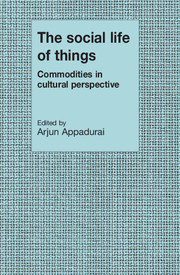Book contents
- Frontmatter
- Contents
- Contributors
- Foreword
- Preface
- Part I Toward an anthropology of thing
- Part II Exchange, consumption, and display
- Part III Prestige, commemoration, and value
- Part IV Production regimes and the sociology of demand
- 7 Weavers and dealers: the authenticity of an oriental carpet
- 8 Qat: changes in the production and consumption of a quasilegal commodity in northeast Africa
- Part V Historical transformations and commodity codes
- Index
8 - Qat: changes in the production and consumption of a quasilegal commodity in northeast Africa
Published online by Cambridge University Press: 05 June 2014
- Frontmatter
- Contents
- Contributors
- Foreword
- Preface
- Part I Toward an anthropology of thing
- Part II Exchange, consumption, and display
- Part III Prestige, commemoration, and value
- Part IV Production regimes and the sociology of demand
- 7 Weavers and dealers: the authenticity of an oriental carpet
- 8 Qat: changes in the production and consumption of a quasilegal commodity in northeast Africa
- Part V Historical transformations and commodity codes
- Index
Summary
This essay examines the circulation and consumption of qat in the changing society and political economy of northeast Africa over the past half century. Qat (gat or khat in Arabic, chat in Amharic) is a small tree or shrub, whose young leaves, stem tips, and tender bark are chewed for their stimulating effect. Qat (Catha edulis) was known and used for medicinal purposes in the medieval Islamic world and in traditional China. It has long been chewed in Yemen, where it may have originated, and more recently has become the chief source of entertainment and group recreation in the towns of Somalia. Fresh-cut leaves and branches are transported daily by road and air across deserts and international frontiers in marketing networks of remarkable scale and complexity. These networks link the hillside farmers of highland Kenya and Ethiopia with the nomadic pastoralists of the Somali plains and with merchants and street vendors in the coastal towns of Somalia and Jibuti (former French Somaliland). The attitudes of government authorities toward qat use have varied from awkward tolerance to outright opposition. Since 1921, bans on qat have been imposed by area governments at least half a dozen times, with little permanent effect. During this period, the economic value and cultural significance of qat have changed. The nature of these changes and the reasons for them provide the central focus for my analysis.
- Type
- Chapter
- Information
- The Social Life of ThingsCommodities in Cultural Perspective, pp. 236 - 258Publisher: Cambridge University PressPrint publication year: 1986
- 36
- Cited by



